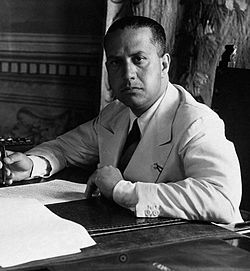Galeazzo Ciano
| Galeazzo Ciano | |
|---|---|
 |
|
| Minister of Foreign Affairs | |
|
In office 9 June 1936 – 6 February 1943 |
|
| Duce | Benito Mussolini |
| Preceded by | Benito Mussolini |
| Succeeded by | Benito Mussolini |
| Minister of Press and Propaganda | |
|
In office 23 June 1935 – 5 September 1935 |
|
| Duce | Benito Mussolini |
| Preceded by | Position established |
| Succeeded by | Dino Alfieri |
| Undersecretary for Press and Propaganda | |
|
In office 6 September 1934 – 26 June 1935 |
|
| Duce | Benito Mussolini |
| Preceded by | Position established |
| Succeeded by | Position abolished |
| Head of the Government Press Office | |
|
In office August 1933 – 4 September 1934 |
|
| Duce | Benito Mussolini |
| Preceded by | Gaetano Polverelli |
| Succeeded by | Position abolished |
| Personal details | |
| Born |
Gian Galeazzo Ciano 18 March 1903 Livorno, Tuscany, Italy |
| Died | 11 January 1944 (aged 40) Verona, Italian Social Republic |
| Cause of death | Executed by firing squad |
| Political party | National Fascist Party (PNF) |
| Spouse(s) | Edda Mussolini (m. 1930) |
| Children | Fabrizio Raimonda Marzio |
| Parents |
Costanzo Ciano (father) Carolina Pini (mother) |
| Profession |
|
| Religion | Roman Catholicism |
Gian Galeazzo Ciano, 2nd Count of Cortellazzo and Buccari (Italian pronunciation: [ɡale'attso ˈtʃaːno]; 18 March 1903 – 11 January 1944) was Foreign Minister of Fascist Italy from 1936 until 1943 and Benito Mussolini's son-in-law. On 11 January 1944, Count Ciano was shot by firing squad at the behest of his father-in-law, Mussolini, under pressure from Nazi Germany. Ciano wrote and left behind a diary that has been used as a source by several historians, including William Shirer in his The Rise and Fall of the Third Reich and in the 4-hour HBO documentary-drama Mussolini and I.
Gian Galeazzo Ciano was born in Livorno, Italy, in 1903. He was the son of Costanzo Ciano and his wife Carolina Pini; his father was an Admiral and World War I hero in the Royal Italian Navy (for which service he was given the aristocratic title of Count by Victor Emmanuel III). He was a founding member of the National Fascist Party and re-organizer of the Italian merchant navy in the 1920s. The elder Ciano, nicknamed Ganascia ("The Jaw"), was not above extracting private profit from his public office. He would use his influence to depress the stock of a company, after which he would buy a controlling interest, then increase his wealth after its value rebounded. Among other holdings, he owned a newspaper, farmland in Tuscany and other properties worth huge sums of money. As a result, his son Galeazzo was accustomed to living a high-profile and glamorous life, which he maintained almost until the end of his life. Father and son both took part in Mussolini's 1922 March on Rome.
...
Wikipedia
